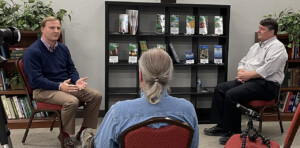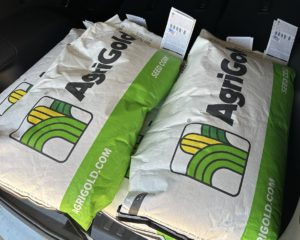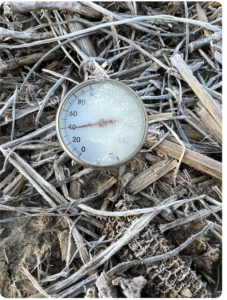You shouldn’t judge a book by its cover, but you can judge seed products by their bag covers. There’s lots of telling information on them. Just look at this bag of seeds going on my farm. The bag itself prominently features the brand name and logo (AgriGold), type of product (corn), the actual product name (A647-79VT2PRO) and weight (61 lbs. in this bag). Seed corn bags contain 80,000 kernels. The heavier the bag, the heavier the weight per kernel. While there are studies suggesting no link between final yield and the weight of the seed, many successful farmers ardently believe this to be true and prefer heavier seeds. Each bag also contains a tag that provides specific information that farmers will want to record.
Here’s a breakout of some of the key information:
- A647-79 indicates the specific product name
- VT2PRO is a branded trait package included in this product. These are biotechnology traits, or GMOs. This trait package from Bayer provides in-plant protection against above-ground pests such as corn borer, armyworm and earworm with two modes of action. I’ve experienced some earworm damage in the past few seasons, and I recently identified armyworms, so I requested this trait package
- RoundupReady 2 means the seed is resistant to Roundup (glyphosate) so farmers can safely apply that herbicide without risking damage to the crop
- Acceleron 250 is a branded seed treatment from Bayer that protects plants from nematodes, insects and diseases.
- Germ is the expected germination rate. That means laboratory studies were conducted with this batch of seeds to predict what percentage of these seeds will emerge. The expectation for this seed is that at least 95% of the seeds will sprout. It could be more, but 95% is expected. So why isn’t there a 100% germination rate? Well, Mother Nature doesn’t work that way
- Relative Maturity indicates how long it will take the plant to reach physiological maturity from the day it’s planted. This hybrid will take 117 days. Physiological maturity doesn’t mean the time from planting to harvest, just when kernels stop taking in water and nutrients. Typically, the further south your farm is located, the longer maturity you can plant
- Origin indicates where the seed was grown. These seeds were grown in Nebraska. Even if they farm in the South, most farmers want seed produced in northern climates, as that implies better hardiness (sort of like wanting your Christmas tree grown in Oregon or Michigan).
#Plant23 had seemingly just gotten rolling, and already, Mother Nature isn’t playing nice. Great conditions during the second week of April signaled planters to the field in much of the Midwest and South. On Sunday, a farmer in Southeast Iowa posted the disturbing photo below. How will the planted corn fare? Hard to tell for sure. A lot depends on the soil temperature when the seed was planted, the moisture uptake, whether or not the seeds had sprouted and the stress tolerance of the hybrid. Sitting in sub-50-degree temperatures is never good. Some studies and reports reveal a yield reduction of 50 bushels, depending on the circumstances. Plant emergence and subsequent crop stands will be impacted to varying degrees. Another big issue is plant vigor, which certainly will be slowed. Many parts of the Midwest are expecting below-freezing temperatures early this week. There was even a frost warning for Memphis earlier this week.
Field preparations have begun on my 10-acre high-yield test field at Agricenter International in Memphis. What makes this plot particularly unique is that all crop nutrition will be provided by Bio Huma Netics (BHN). Short of any unforeseen events, the only crop inputs not BHN branded will be the seed and herbicide. Look closely at the soil. It’s certainly not going to be confused for rich, black Illinois dirt. The organic matter, which comprises the fertile layer of topsoil, is only 2.1%. The first order of business will be to breathe life into this soil. We’ll start that process with a pre-plant application of Huma Gro® Zap® and K Hume® next week. This will stimulate populations of soil microbes and improve soil fertility. Then we’ll build seed beds and plant the crop in early May.
BHN is proud to serve as Gold Sponsor for the 2023 TopSoil Summit, held June 5 in Riverside, Iowa (just south of Iowa City). Hosted by soil health consulting company Continuum Ag, the TopSoil Summit brings together 400 farmers and industry professionals to discuss and showcase soil health and regenerative practices. This is an excellent opportunity to meet growers who represent our “low hanging fruit” and align with the movers and shakers of the regen ag movement. Just like at the recent Soilcraft Regen Ag Conference, all TopSoil Summit attendees are believers in soil health/regen ag, although they may be at various stages in their journey.
Regen ag is an actual mindset, not just a series of farming or ranching practices. That’s the takeaway from this fascinating 14-minute documentary, “From the Ground Up — Regenerative Agriculture.” Although it’s shot in Australia, these practices can be applied anywhere. Please check it out.
The world’s greatest profession is also the most hazardous. Farm safety hits way too close to home for me. My grandfather lost his eyesight in a farm accident. A hose broke on an anhydrous ammonia tank and sprayed into his eyes. He was not wearing goggles at the time, as that was not common in those days. Nearly 250 U.S. agricultural workers suffer serious injuries or death every day because of farm accidents. Farming has the highest fatality rate of all industries; 573 fatalities occur annually from farm-related accidents. About half of ag fatalities involve machinery, such as tractor overturns, collision and accidental pinning. Fatigue is a main culprit, due to working long days and nights. The work is physical and requires heavy concentration. Tight windows of time are required to perform much of the work and farmers may be distracted by multi-tasking. Now is one of the most dangerous times of the year, as farmers coast-to-coast rush to plant their crops. But not all farm-related accidents occur in fields and barnyards. Country roads are treacherous right now, as impatient motorists come in frequent contact with slow-moving machinery. My friends at Agricenter International offer these free Farm Safe online training courses, and in-person and remote training. I strongly encourage all ag industry professionals to take these courses.
Related Posts

Interview with The Fertilizer Institute’s CEO, Corey Rosenbusch
BHN CEO Lyndon Smith and The Fertilizer Institute’s President & CEO Corey Rosenbusch discuss TFI’s mission and vision, programs and initiatives, and challenges facing the fertilizer industry.

Earth Day: “It’s Getting Better All the Time”
Celebrating Earth Day every April 22 is a great time to pause and reflect: How are we, today, treating the environment and the plants, animals, and people who live in it? What have we accomplished in the past year that makes our planet a better, more sustainable place to live and raise our families? What are our goals for future improvement?

Caffeine in Our Water Supply: Do Our Habits Pollute the Environment?
Caffeine is excreted by the body and flushed into our wastewater. Wastewater, in turn, is treated and recycled back into the environment, or––in some cases––directly back into drinking water.




